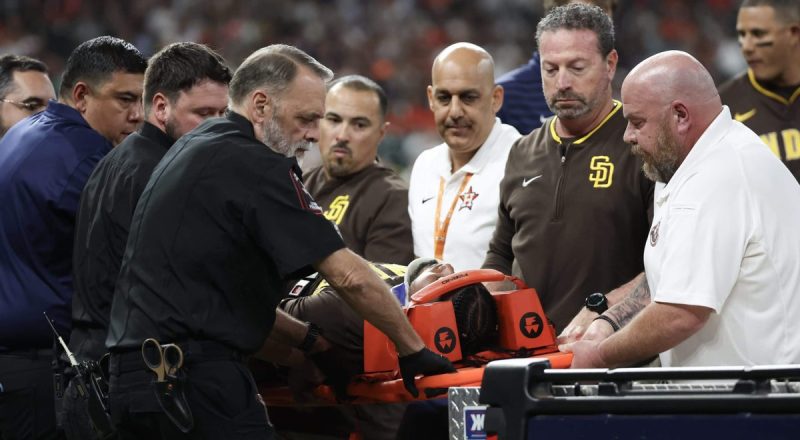The collision at first base happened three days ago, and Mike Shildt still can’t get it out of his head. Now, he thinks Major League Baseball should do more to head off future crashes at first base.
It was Sunday night in Houston, and the manager of the San Diego Padres was standing alongside the limp figure of his three-time batting champ, Luis Arraez, praying everything would be OK.
Three days later, in an appearance on the latest Starkville podcast, Shildt is still using words like “scary” and “alarming” to describe what he saw after a frightening play in which Arraez ran face-first into the shoulder of Houston’s Mauricio Dubón.
“Very scary,” he told me and Doug Glanville on Starkville, which is part of “The Windup” show on The Athletic. “We don’t see collisions like that a lot in our game. (So I sprinted) out onto the field as quickly as possible. And he’s motionless … lost a little bit of consciousness for a brief period of time. Then got his eyes open and then got him moving a little bit. But it was still very scary.”
Fortunately, Shildt said, it looks like Arraez avoided all the worst-case scenarios. He is currently on the seven-day injured list, working his way through MLB’s concussion protocols. But that doesn’t mean the league should overlook its chance to be proactive in trying to prevent similar collisions.
In college baseball, the NCAA has instituted what is known as “the double first base rule.” It is a safety measure that places two bags at first base for use on close plays — one bag for the defender, one for the base runner. Asked if he would be in favor of MLB trying out that idea, Shildt saw no downside.
“I wouldn’t be opposed to it,” he said. “I haven’t seen it or played with it, to form a real strong opinion. But conceptually, it’s one of those things where you go: You know, why not? I mean, we want our players to be safe and on the field, so I don’t really see a huge reason (not to).
“Conceptually, it does check some boxes to me that make sense — that listen, let’s just create a lane for everybody.”
The Southeastern Conference tried out the double base in its tournament last year, to good reviews, and it’s now in effect across all of college baseball. There is a white bag for the fielder and a green or orange bag for the runner. And while there are certain exceptions, where the first baseman or runner are permitted to tag the other bag, even those exceptions were crafted with player safety as the goal.
Shildt endorsed the rule changes MLB made last season to clarify where base runners can run as they’re heading toward first base. But then he circled back to the double first-base idea and said: “I don’t see why not.”
“I don’t think it’s going to hurt the integrity of the game,” he said. “And it actually kind of preserves the safety of our players. So we should probably think about it.”

Shildt said Arraez flew back to San Diego on Monday, rather than accompanying the Padres to Detroit, but seems to be recovering well so far.
“He’s sore, as you would expect,” Shildt said. “But nothing from a CT scan that’s alarming in the cervical area or the jaw line, because he got a little abrasion on his jaw. And cognitively, (he’s) alert, remembers what’s taken place, is testing positively to this point on anything relative to the concussion side of it.”
Shildt also reported that Arraez has soreness and limited range of motion in his neck area. But “all things being considered,” the manager said, “it looks like he’s going to be OK.”
Nevertheless, the force of that collision — and the frightening 11-minute delay that followed — left a mark on everyone on the field. Human beings play these games. And both teams were shaken by the sight of two bodies colliding at top speed.
“Everybody’s heart just went out for him,” Shildt said. “The competition went out the window. We’re in the third game of a very, very hard-fought series that continued after that incident. But now, it’s just about humans, you know. And that’s one thing about that … is the brotherhood that is Major League Baseball and baseball in general, and how people care about each other.
“And that was on display immediately after that. The Astros — the organization, and medically — everybody was first class and very accommodating. We’re very grateful for that. So people all pitched in to make the best of a tough situation.”
Shildt’s remarks about Arraez were only part of a wide-ranging conversation on Starkville. He talked about why Fernando Tatis Jr. could represent the future of baseball. He described the evolving role managers now play in establishing clubhouse culture. And he was candid in explaining how his firing in St. Louis has affected him in this job and left him “a little more aware of how the industry works.”
To hear Shildt discuss all that and more, listen to the full podcast here.
(Top photo: Thomas Shea / Imagn Images)
